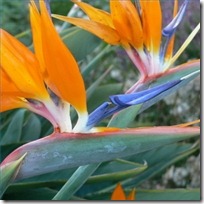The Bird of Paradise plant, scientifically known as Strelitzia reginae, features large bluish-green leaves and spectacular, long-stemmed orange-and-blue blooms that emerge from canoe-shaped bracts and resemble birds in flight. This exotic-looking native of South Africa–also known as the crane plant–is widely grown as an ornamental planting in southern California and Florida, and can grow to be 5 feet tall and 3 feet wide. Because it tolerates salt air well, it is often used in seaside gardens. If you are lucky enough to have a large Bird of Paradise plant, you can keep it healthy and producing its stunning flowers by following some simple gardening guidelines.
Difficulty: Moderately Easy
Instructions
Things You’ll Need:
- Organic mulch
- General purpose water-soluble fertilizer
- Plant mister
- Pruning shears
- Insecticidal soap (optional)
- Yellow sticky cards, available at garden supply stores (optional)
-
Plant your Bird of Paradise in rich, loamy, well-drained soil and in full sun; for maximum flowering, Birds of Paradise need at least four hours of direct sunlight a day. Take care not to plant it too deeply–this plant blooms best when some of its roots are at or near the surface. Don’t plant your Bird of Paradise in the ground if temperatures routinely go under 50 degrees, or if there is any danger of frost in your area. Plant it in a container so it can be brought inside.
-
Mulch well to prevent weeds, conserve moisture and protect roots.
-
Water your Bird of Paradise generously, especially in its first year, to promote healthy establishment of roots. Keep soil consistently moist in the summer; in the fall and winter, allow the soil to dry out slightly between waterings. Watch for yellowing leaves, a danger sign that can indicate either under-watering or sogginess due to poor drainage and over-watering.
-
Fertilize your Bird of Paradise plant before new growth in the spring, using a general- purpose water-soluble fertilizer, and repeat every two weeks during the growing season. In winter, fertilize once a month.
-
Mist your Bird of Paradise during the winter to give it some of the humidity it craves.
-
Prune your Bird of Paradise in spring, cutting away all faded blooms and flower stalks. In the dormant season, prune branches back by one half to promote new growth and encourage flowering.
-
Watch for scale insects and aphids, garden pests that can infest your Bird of Paradise. Treat them both with insecticidal soap. You can also control aphids by picking them off by hand and squashing them, as well as by using yellow sticky traps.
Tips & Warnings
-
Bird of Paradise plants can be divided at the root after their second year, but this will prevent any blooms for several years after.
-
Keep dogs away from your Bird of Paradise. Although dogs like to nibble on this plant, the seeds are toxic and can cause abdominal pain and vomiting.


Deprecated: strpos(): Passing null to parameter #1 ($haystack) of type string is deprecated in /home/agriviek8Qv/agriviet.net/public_html/wp-includes/comment-template.php on line 2522